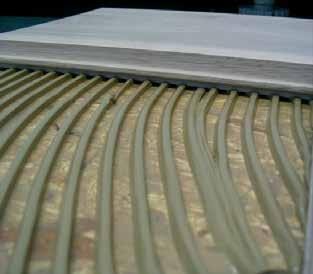
4 minute read
THE START OF A PERFECT PARQUET BONDING
WOOD REQUIRES ATTENTION
Moisture content
Advertisement
Wood tends to keep its moisture content in balance with the humidity of the air or the environment. Until the equilibrium moisture content is reached, the wood will absorb moisture from the air or release moisture to the air. These fluctuations in wood moisture content will usually cause the wood to swell or shrink. The hygric movement is most pronounced in the tangential plane (file plane) of a wooden element.
Other influencing factors
In addition to the drying quality of the wood, other factors can also influence the dimensional stability of wood: the type of wood, the wood quality, the cutting method, the slenderness of the profile, the presence of shrink grooves, the method of installation and the structure of multi-layer parquet...
Slicing technique quarter-cut: Slicing technique crown-cut:
The slenderness factor of a profile
The slenderness factor of a rectangular element is defined by the ratio between the width and the thickness of the element. With slim profiles (e.g. wide and thin parquet strips) considerable deformations can occur. It is therefore important that a suitable adhesive is selected for this. Example: solid oak parquet of 200 mm wide and 20 mm thick has a slenderness factor of 10 (= 200/20) Width
Slenderness factor = width / thickness
Thickness
Acclimatizing wood
Let the parquet acclimatize in the original packaging for a few days in the relevant room. The recommended ambient temperature is 16°C - 22°C with a relative humidity between 30% and 60%.
Check moisture content
Check the moisture content of the wood before installation and compare it with the value prescribed by the manufacturer. Placement is strongly discouraged below 7% or above 11% wood moisture.
INDOOR
The relative humidity must stand between 30% and 60%. The air temperature must be at least 16°C. The subsurface temperature must be at least 10°C and at least 3°C above the dew point of the ambient air in order to avoid condensation.
Table: Dew point (°C) in function of the temperature (°C) and the relative humidity of the ambient air (%)
Air temperature Relative Humidity

The substrate must also meet certain requirements before installing parquet: × The substrate must be horizontal and sufficiently flat. If necessary, the flatness can be improved by leveling with DL Egaline or DL Maxi Egaline. × The surface must be sufficiently dry. Optionally, a moisture barrier can be applied with Hydroblocker 2K or Hydroblocker 3K. × The substrate must be strong enough with a good surface cohesion. A primer such as Primer WB, Primer PU Turbo and Hydroblocker 2K can in some cases improve the surface condition. Any cracks in the screed can be repaired with a synthetic repair mortar (Hydroblocker 2K + sand). × Smooth surfaces such as ceramic tiles and polished concrete must be degreased and scratched well.
UNDERFLOOR HEATING
If the parquet is installed on underfloor heating, it must be turned off at least 48 hours before gluing.
CHOOSE THE RIGHT ADHESIVE TROWEL
Adhesive trowel Serration* Applications Consumption Trowel width Packaging
B11 8.2 | 5.8 | 5.0 Solid parquet Multi-layer parquet Industrial parquet End grain wood floor 900 - 1200 g/m² 20 cm Set of 5 pieces
Tip: Hold the adhesive trowel at an angle of 60° for optimal spreading of the adhesive.
It may be necessary to use an adhesive trowel with coarse serration (such as B16) for the bonding of long, wide planks and for bonding on uneven surfaces. For mosaic parquet, lamparquet, wood veneer... an adhesive trowel with small serrations (such as B3) can be used.
(*) Serration a | b | c (in mm)
c (tooth height) | a (tooth back width) ____ b (tooth width) ____
THE IMPORTANCE OF THE RIGHT ADHESIVE SELECTION
There are different types of parquet adhesive, of which the 1-component polymer adhesives and the 2-component (epoxy) polyurethane adhesives can be used for most applications due to their versatility.
The choice of adhesive depends, among other things, on the nature and flatness of the substrate, the properties and dimensions of the floor elements, the moisture sensitivity of the wood, the presence of underfloor heating, the compatibility with the substrate and any primers, the processing properties...
Rigid or flexible adhesives
Rigid adhesives are recommended if you want to counteract the movement of the wood. Due to their strong adhesion and low stretch, these adhesives will increase the burden on the substrate. This adhesive type therefore requires a substrate with high cohesive strength, otherwise the transmitted stresses can lead to an adhesive fracture of the substrate.
Flexible adhesives can compensate for the movements of the wood due to their elastic nature and then return to their original shape.

DL Chemicals parquet adhesives can be classified according to their strength and elasticity:



